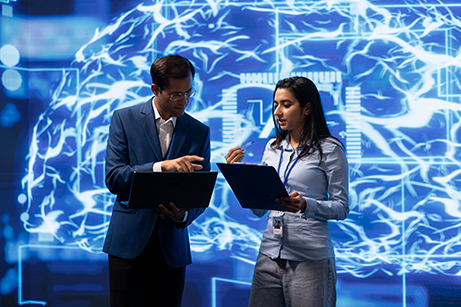AIMC Topic: Tissue Engineering
Clear Filters Showing 1 to 10 of 102 articles
Computational optimization of 3D printed bone scaffolds using orthogonal array-driven FEA and neural network modeling.
Scientific reports
Aug 20, 2025
Today, orthopedic surgeons have been continuously focusing on bone tissue engineering for regenerating damaged bone through the use of biomimetic scaffolds and innovative materials. Hence, this study presents a comprehensive investigation into the op...
Computer vision to predict cell seeding coverage in re-endothelialized mouse lungs.
Scientific reports
Jul 19, 2025
Transplantation of donor grafts recellularized with recipient-derived or non-immunogenic universal cells is a potential means of reducing the graft rejection and post-transplant complications in lung transplantation. Achieving a fully recellularized ...
Decoding tissue complexity: multiscale mapping of chemistry-structure-function relationships through advanced visualization technologies.
Journal of materials chemistry. B
Jul 10, 2025
Comprehensively acquiring biological tissue information is pivotal for advancing our understanding of biological systems, elucidating disease mechanisms, and developing innovative clinical strategies. Biological tissues, as nature's archetypal biomat...
Divide-and-conquer strategy with engineered ossification center organoids for rapid bone healing through developmental cell recruitment.
Nature communications
Jul 4, 2025
Current approaches for bone repair predominantly target localized delivery of growth factors that are aimed at the coupling of angiogenesis and osteogenesis. However, delayed revascularization and regeneration of critical-sized bone defects are still...
Discovering novel type I collagen fragments from Cyprinus carpio supporting bone regeneration.
Functional & integrative genomics
Jul 4, 2025
Fish collagen is gaining increasing attention in tissue engineering due to its exceptional bioactivity. This study aimed to isolate functional fish collagen fragments capable of microbial biosynthesis and supporting bone tissue regeneration. Collagen...
Biomanufacturing in low Earth orbit: A paradigm shift.
Stem cell reports
Jun 19, 2025
This perspective article explores the transformative potential of biomanufacturing in low Earth orbit (LEO) for regenerative medicine. Building on key symposia and workshops, it highlights the International Space Station (ISS) National Laboratory's r...
A soft robotic total artificial hybrid heart.
Nature communications
Jun 3, 2025
End-stage heart failure is a deadly disease. Current total artificial hearts (TAHs) carry high mortality and morbidity and offer low quality of life. To overcome current biocompatibility issues, we propose the concept of a soft robotic, hybrid (pumpi...
Measuring alignment of structural proteins in engineered tissue constructs using polarized Raman spectroscopy.
PloS one
May 30, 2025
Measures of structural protein alignment within biological and engineered tissues are needed for improved understanding of their mechanical behavior and functionality. We advance our method of measuring protein alignment using polarized Raman spectro...
Optimal structural characteristics of osteoinductivity in bioceramics derived from a novel high-throughput screening plus machine learning approach.
Biomaterials
Apr 16, 2025
Osteoinduction is an important feature of the next generation of bone repair materials. But the key structural factors and parameters of osteoinductive scaffolds are not yet clarified. This study leverages the efficiency of high-throughput screening ...
Surrogate modeling of electrospun PVA/PLA nanofibers using artificial neural network for biomedical applications.
Scientific reports
Apr 15, 2025
Blending poly (lactic acid) (PLA) with poly (vinyl alcohol) (PVA) improves the strength and hydrophilicity of nanofibers, making them suitable for biomedical applications like wound dressings. This study explores how electrospinning parameters-applie...
Popular Topics
- Machine Learning 32021
- Neural Networks, Computer 30231
- Algorithms 27405
- Deep Learning 26912
- Artificial Intelligence 24844
- Robotics 13389
- Image Processing, Computer-Assisted 9738
- Retrospective Studies 9346
- Magnetic Resonance Imaging 6347
- Reproducibility of Results 5670
- Tomography, X-Ray Computed 4866
- Support Vector Machine 4771
- Computational Biology 4333
- Brain 4129
- Computer Simulation 3935
Recent Journals
- Scientific reports 6800
- Sensors (Basel, Switzerland) 4794
- PloS one 4210
- Neural networks : the official journal of the International Neural Network Society 3026
- Computational intelligence and neuroscience 1931
- Computers in biology and medicine 1916
- Annual International Conference of the IEEE Engineering in Medicine and Biology Society. IEEE Engineering in Medicine and Biology Society. Annual International Conference 1686
- Studies in health technology and informatics 1378
- IEEE journal of biomedical and health informatics 1172
- Journal of chemical information and modeling 1066
- Nature communications 1047
- Computer methods and programs in biomedicine 883
- Bioinformatics (Oxford, England) 874
- Journal of medical Internet research 864
- Briefings in bioinformatics 853
